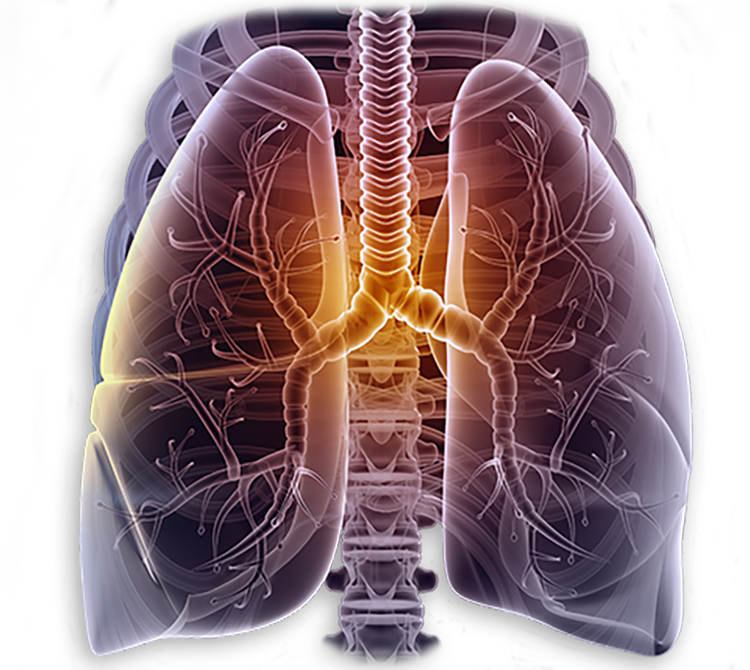Pulmonary Disease Models
Customized Models and Services for Drug Discovery

Advancing Pulmonary Disease Drug Discovery
Pulmonary diseases encompass a range of serious conditions that impair respiratory function and breathing, affecting a substantial portion of the global human population. Obstructive pulmonary disorders, such as chronic obstructive pulmonary disease (COPD) and asthma, block airflow and hinder exhalation, while restrictive pulmonary diseases, including idiopathic pulmonary fibrosis, reduce lung expansion. Acute lung injury is marked by an exudative phase involving pulmonary edema and inflammation, leading to severe hypoxemia. Globally, chronic respiratory conditions rank among the leading causes of death, accounting for millions of fatalities each year. Despite existing therapies, disease progression remains a significant challenge, highlighting the urgent need for new therapeutic entities that address complex human disease mechanisms and improve patient outcomes.
As a preclinical discovery research organization, Inotiv provides comprehensive in vivo models and pharmacology services to drive advancements in human pulmonary disease drug discovery and development. Our robust models replicate critical features of obstructive, restrictive, and vascular pulmonary conditions, enabling precise assessment of therapeutic efficacy, safety, and disease mechanisms. With customized study designs and expert scientific guidance, we collaborate closely with clients to address key research objectives, delivering high-quality data that informs decision-making and accelerates preclinical programs.
In Vivo Models of Pulmonary Diseases
Asthma Models
Asthma is a complex disorder marked by chronic airway inflammation, hyperresponsiveness (AHR), and airway resistance and remodeling. Eosinophilic inflammation is a key feature of asthmatic airways and plays a critical role in the pathogenesis of allergic asthma. Inflammation and narrowing of the airways, along with excess mucus production, can cause wheezing, coughing, chest tightness, and inhalation difficulties. Asthma affects millions of Americans, including children, and is responsible for millions of emergency department visits and tens of billions of dollars in healthcare costs each year.
Key Models
- House Dust Mite (HDM)-Induced Asthma Mouse and Rat Model
- Ovalbumin (OVA)-Induced Asthma Mouse and Rat Model
Chronic Obstructive Pulmonary Disease (COPD) Models
COPD is a progressive disorder that makes breathing difficult, characterized by chronic airway inflammation, mucus hypersecretion, airway remodeling, and emphysema, which reduce respiratory function and cause breathlessness. It develops gradually, with periodic exacerbations triggered by inflammatory responses to substances like cigarette smoke, air pollution, dust from mining or wood products, bacteria, or viruses. COPD is a leading cause of death worldwide.
Key Models
- Porcine Pancreatic Elastase (PPE)-Induced COPD Mouse and Rat Model
Idiopathic Pulmonary Fibrosis (IPF) Models
IPF is the most common type of pulmonary fibrosis, a disorder that causes scarring (fibrosis) of the lungs. The buildup of scar tissue leads to lung stiffness, reducing their ability to expand and making it increasingly difficult to breathe. Over time, the progressive nature of IPF results in severe respiratory function decline, significantly impacting quality of life and life expectancy.
Key Models
- Bleomycin-Induced IPF Mouse and Rat Model
Acute Lung Injury (ALI) Models
ALI refers to clinical syndromes of acute respiratory failure, associated with significant morbidity and mortality. ALI occurs when the lungs become inflamed, impairing gas exchange. It can result from direct lung injuries, such as acid aspiration, or indirect injuries, like systemic infection. Recent advances have improved our understanding of ALI's epidemiology, pathogenesis, and treatment. However, further progress is needed to reduce its mortality and morbidity.
Key Models
- Lipopolysaccharide (LPS)-Induced ALI Mouse and Rat Model
Pulmonary Arterial Hypertension (PAH) Models
PAH is a rare, progressive lung disease characterized by elevated blood pressure in the lungs. In PAH, the small arteries in the lungs thicken and narrow, restricting blood flow and increasing vascular pressure. This forces the heart to work harder to pump blood through the lungs, eventually weakening its ability to circulate blood effectively throughout the body.
Key Models
- Monocrotaline-Induced PAH Rat Model
Not seeing the model you need? Explore our full range of Cardiovascular Disease animal models or contact us to discuss developing a new model of lung disease for your drug development program. Our strong focus on research and development fuels the ongoing development of novel models and the enhancement of established disease models, delivering advanced solutions customized to meet your research goals.
Selected Study Endpoints
In preclinical drug discovery and development for pulmonary diseases, we provide a comprehensive selection of key endpoints to evaluate therapeutic efficacy and safety. We understand that every research program has unique goals, and our team works closely with you to identify the most appropriate endpoints for your therapeutic objectives and study requirements. Below is a sample of our capabilities; however, we offer an extensive range of services and collaborate closely with our clients to develop customized solutions tailored to their specific research needs.
- Lung function
- Bronchoalveolar lavage (BAL)
- Immunophenotyping via flow cytometry
- Comprehensive panel of pulmonary biomarkers
- Histology and pathology
Comprehensive Services for Drug Development
We provide a full suite of research services to support every stage of drug development, from early discovery to the critical data required for IND filings. Our integrated approach streamlines the process, enhancing efficiency and effectiveness. With a focus on customized solutions, we deliver robust, translational data to drive successful outcomes. Our expertise in preclinical research ensures rigorous evaluation of drug candidates, providing valuable insights to inform development decisions. Explore our key service areas, each designed to support drug discovery and development with precision and expertise.
In Vivo Models for Other Cardiovascular and Related Diseases
Failure Heart
Failure Inotiv provides translational rodent and large animal models, along with flexible research services and expert consultation, to accelerate heart failure drug discovery. Our in vivo pharmacology services deliver clinically relevant insights and robust efficacy data.
Disease Metabolic
Disease Inotiv supports diabetes, obesity, and metabolic disease research with in vivo models and tailored pharmacology studies. Our translational models deliver clinically relevant insights, with expert guidance from study design to data interpretation to advance therapeutic development.
Disease Renal
Disease Inotiv offers a diverse portfolio of rodent models of kidney disease and preclinical research services that support drug discovery efforts with clinically relevant and customizable solutions.
Disease Hepatic
Disease Inotiv supports liver disease research with translational models and comprehensive ex vivo and in vivo services. We offer expert guidance and customizable studies to evaluate efficacy, safety, and mechanisms—advancing drug discovery with meaningful, clinically relevant results.



